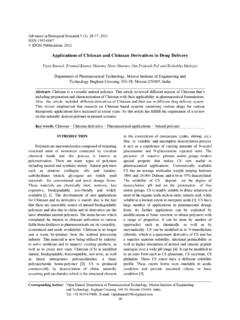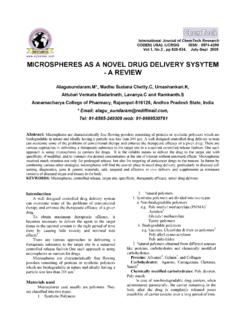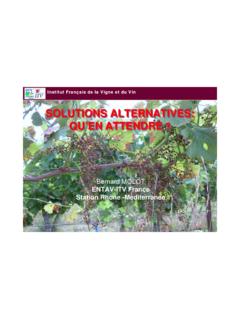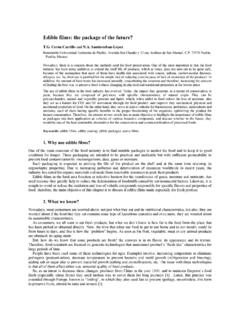Transcription of PREPARATION AND APPLICATION OF CHITOSAN …
1 ISSN 0104-6632 Printed in Brazil Vol. 28, No. 03, pp. 353 - 362, July - September, 2011 *To whom correspondence should be addressed Brazilian Journal of Chemical Engineering PREPARATION AND APPLICATION OF CHITOSAN NANOPARTICLES AND NANOFIBERS Li-Ming Zhao1, Lu-E Shi2, Zhi-Liang Zhang2, Jian-Min Chen2, Dong-Dong Shi2, Jie Yang2 and Zhen-Xing Tang1* 1 Department of Food Science and Technology, College of Biotechnology, Phone: +86-21-64250829, East China University of Science and Technology, 200037, Shanghai, China. E-mail: 2 College of Life and Environmental Sciences, Hangzhou Normal University, 310036, Hangzhou, Zhejiang, China. (Submitted: February 23, 2011 ; Revised: March 25, 2011 ; Accepted: April 20, 2011) Abstract - Encapsulation and immobilization technology is important for the food processing and bioengineering industries.
2 CHITOSAN is a natural polysaccharide prepared by the N-deacetylation of chitin. It has been widely used in food and bioengineering industries, including the encapsulation of active food ingredients, in enzyme immobilization, and as a carrier for controlled drug delivery, due to its significant biological and chemical properties such as biodegradability, biocompatibility, bioactivity, and polycationicity. In this work, CHITOSAN nanoparticles and nanofibers used to encapsulate bioactive substances and immobilize enzymes were reviewed. PREPARATION of CHITOSAN nanoparticles and nanofibers, including the work achieved in our group on CHITOSAN nanoparticles for enzyme immobilization, were also introduced. Some problems encountered with nano-structured CHITOSAN carriers for bioactive substance encapsulation and enzyme immobilization were discussed, together with the future prospects of such systems.
3 Keywords: CHITOSAN ; Encapsulation; Bioactive substances; Immobilization. INTRODUCTION Functional bioactive ingredients have received much attention in recent years from the scientific community, consumers and food manufacturers. Potential functional bioactive ingredients are vitamins, probiotics, bioactive peptides, antioxidants, etc. Scientific evidence to support the concept of health-promoting ingredients is growing steadily. Innovative functional foods that bring physiological benefits or reduce long-term risks of developing diseases are being developed by the scientific community (Elliott and Ong, 2002). However, due to the instability of functional ingredients under conditions encountered during processing (temperature, oxygen, light) or in the gut (pH, enzymes, presence of other nutrients), it is difficult to retain the health benefits of functional ingredients (Bell, 2001).
4 Therefore, it is necessary to protect these molecules from harsh conditions by encapsulation or immobilization. Recently, various micro/nano carriers, particularly nanoparticles and nanofibers, have become available for enzyme immobilization (Jia et al., 2002; Kim and Grate, 2003; Lee et al., 2004; Sawicka et al., 2005; Wei et al., 2000). Typically, smaller particles provide a larger surface area for the attachment of enzymes (Jia et al., 2003) and a shorter diffusional path for the substrates. Thus, nano-structured carriers have been utilized as carriers for enzyme immobilization (Govardhan, 1999; Haring and Schreier, 1999; Xu et al., 1996; Kim et al., 2005). 354 Li-Ming Zhao, Lu-E Shi, Zhi-Liang Zhang, Jian-Min Chen, Dong-Dong Shi, Jie Yang and Zhen-Xing Tang Brazilian Journal of Chemical Engineering CHITOSAN is a partially deacetylated polymer of N-acetyl glucosamine that can be obtained through alkaline deacetylation of chitin.
5 It consists of a -(1,4)-linked-D-glucosamine residue with the amine groups randomly acetylated (Sevda and McClureb, 2004). The amine and OH groups endow CHITOSAN with many special properties, making it applicable in many areas and easily available for chemical reactions. CHITOSAN is safe, non-toxic and can interact with polyanions to form complexes and gels (Sunil et al., 2004; Se and Niranjan, 2005). In this work, the PREPARATION of CHITOSAN nanostructures and their APPLICATION as bioactive ingredient encapsulators or immobilizers are reviewed. PREPARATION OF CHITOSAN NANOPARTICLES AND NANOFIBERS PREPARATION of CHITOSAN Nanoparticles Nanoparticles are defined as particulate dispersions or solid particles with a size in the range of 1 1000 nm. Methods, such as the emulsion method, ionic gelation method (Ohya et al.)
6 , 1994; Yokohama et al., 1998; Kataoka et al., 2000), reverse micellar method, self-assembling method (Liu et al., 2005; Chen et al., 2003), etc., have been used to prepare CHITOSAN nanoparticles. Here, the ionic gelation method and reverse micellar method are mainly considered. Ionic Gelation Method CHITOSAN nanoparticles can be prepared by the interaction of oppositely charged macromolecules. Tripolyphosphate (TPP) has often been used to prepare CHITOSAN nanoparticles because TPP is nontoxic, multivalent and able to form gels through ionic interactions. The interaction can be controlled by the charge density of TPP and CHITOSAN , which is dependent on the pH of the solution. Nasti et al. (2009) studied the influence of a number of factors, such as pH, concentration, ratios of components, and method of mixing, on the PREPARATION of CHITOSAN /TPP nanoparticles.
7 Lin et al. (Lin et al., 2007) investigated the relationship between free amino groups on the surface and the characteristics of CHITOSAN nanoparticles prepared by the ionic gelation method. These factors were unaffected by TPP concentration in these references. A new and simple method to prepare magnetic Fe3O4- CHITOSAN nanoparticles by cross-linking with TPP, precipitation with NaOH and oxidation with O2 in aqueous hydrochloric acid containing CHITOSAN and Fe(OH)2 was developed by Wu et al. (Wu et al., 2009). Transmission electron microscopy (TEM) showed that the diameter of the magnetic Fe3O4 CHITOSAN nanoparticles was 50-100 nm. The capacity of lipase adsorption onto the nanoparticles could reach 129 mg/g; and the maximal enzyme activity was mol min 1 mg 1 (protein) and activity retention was as high as at mg protein/mg nanoparticle concentration.
8 Reverse Micellar Method Ultrafine polymeric nanoparticles with a narrow size range can be prepared with this method. The surfactant is dissolved in an organic solvent to prepare reverse micelles. An aqueous solution of CHITOSAN is added with constant agitation to avoid any turbidity. The aqueous phase is regulated in such a way as to keep the entire mixture in an optically transparent microemulsion phase. More water should be added if nanoparticles of a larger size are to be prepared. Brunel et al. (2008) used a reverse micellar method to prepare CHITOSAN nanoparticles. The lower the molar mass of CHITOSAN , the better the control over particle size and size distribution, probably as a result of either a reduction in the viscosity of the internal aqueous phase or an increase in the disentanglement of the polymer chains during the process.
9 Mansouri et al. (2010) prepared Bovine Serum Albumin (BSA)-loaded CHITOSAN nanoparticles using the reverse micellar method. Particles were obtained in the size range of 143 to 428 nm. The FTIR spectrum indicated that BSA was successfully encapsulated into the CHITOSAN nanoparticles. The CHITOSAN concentration and BSA loading played an important role in the release of BSA. Increasing the CHITOSAN solution concentration decreased the release of BSA, both with a BSA loading of 10% and 20%, while decreasing the BSA loading accelerated the release of BSA at either a CHITOSAN concentration of and Magnetic CHITOSAN nanoparticles were prepared by a reversed phase suspension method using Span-80 as an emulsifier and glutaraldehyde as cross-linking reagent (Fang et al., 2009). Laccase was immobilized on the CHITOSAN nanoparticles.
10 The immobilized laccase exhibited an appreciable catalytic capability and had good storage stability and operation stability. The Km of immobilized and free laccase were and M in phosphate buffer ( M, pH ), respectively. The immobilized laccase is a good candidate for the research and development of biosensors based on laccase catalysis. PREPARATION and APPLICATION of CHITOSAN Nanoparticles and Nanofibers 355 Brazilian Journal of Chemical Engineering Vol. 28, No. 03, pp. 353 - 362, July - September, 2011 PREPARATION of CHITOSAN Nanofibers Nanofibers are defined as solid particles with a dimension in the range of 1 1000 nm. Methods such as the sol-gel method, chemical vapor deposition method, electrospinning method, thermal oxidation method, etc.
















